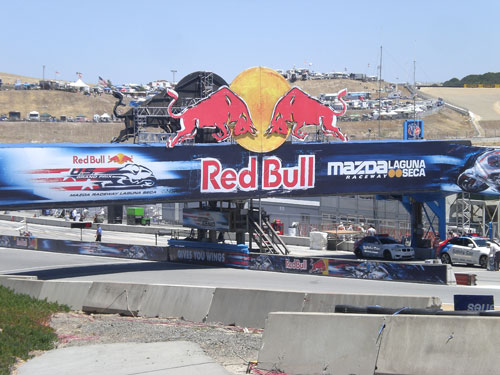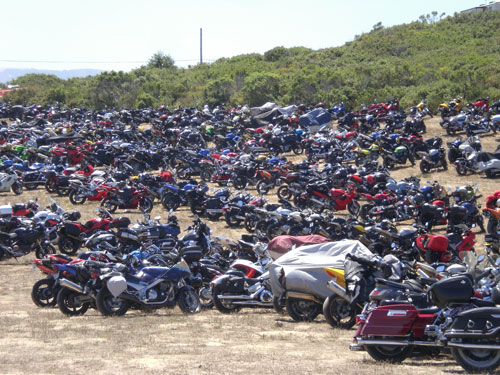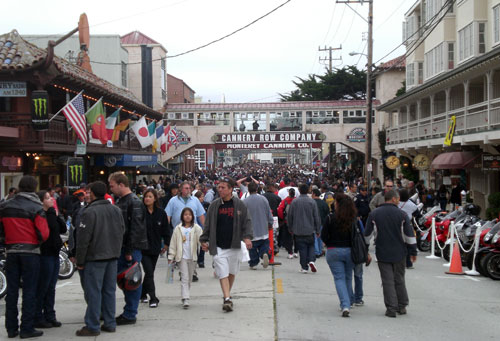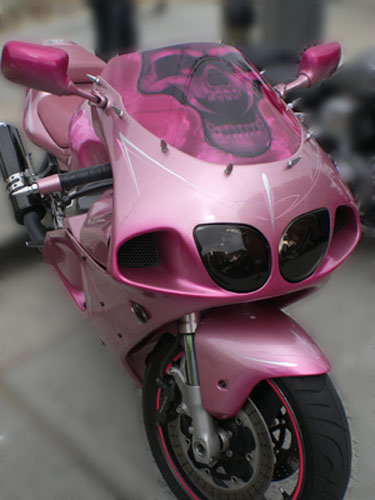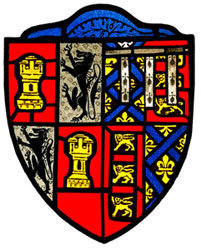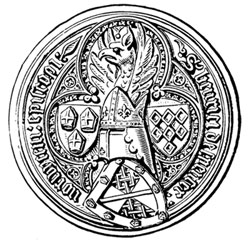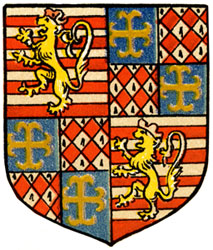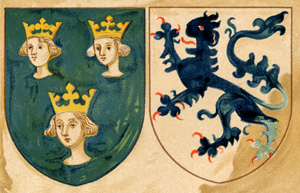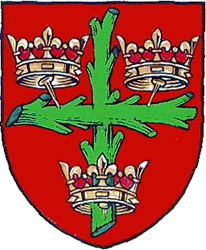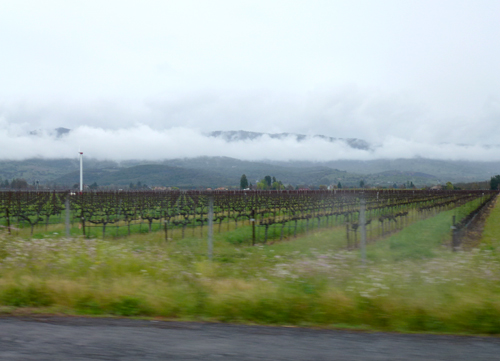
On the Road to Yountville
My husband, Michael, had been bugging me for the last couple of years to go to Taste of Yountville, which is a food and wine tasting event in the town of Yountville in the Napa Valley. We are very fortunate to live about 35 minutes from Yountville, but it was cold and drizzly; I was hesitant.
“We never go anywhere in the rain,” said my adventurous husband. Taking that as a personal challenge, I agreed to go.
Despite the gray dampness, we were surrounded by lush, beautiful greenery. The mustard seed filled in the rows of grapevines with their sunny yellowness. Thick white clouds hung low along the valley mountaintops. I made some desperate attempts at grabbing pictures of the scenery along the road as we whizzed by.

More Road Side Views
For those of you who may not be familiar with Yountville, it’s a dining mecca. Pete Fish, in a 2008 issue of Sunset magazine said that Yountville “boasts more Michelin stars per capita than any place on earth.” It’s home to the world famous restaurant, The French Laundry (which I will never be able to afford), as well as many other fabulous restaurants such as Bouchon, Bistro Jeanty, Bottega, Redd, Hurley’s, and Ad Hoc, among others. We’ve eaten at a few of these on special occasions and have always been overwhelmed by the incredible food. So a wine and food tasting along the main boulevard sounded like a wonderful thing . . . which it was, despite the wet weather.
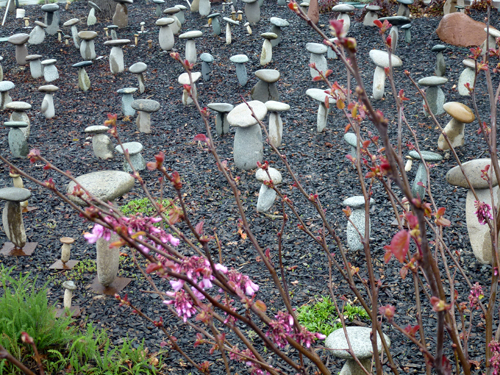
Rock Mushroom Garden by Rich Botto
We got into town and found a parking spot on Mulberry, right off of Washington — the main street in town. We walked to the Community Center, passing the Mushroom Garden along the way. The Mushroom Garden is part of Yountville’s Art Walk. Michael and I each bought a tasting passport – $25 for a wine glass and ten tickets. There were lots of tables under canopies along the street where we could trade our tickets for half glasses of wine and little bites of food.

Primroses and Iceland Poppies in Front of the V Marketplace

Tulips in Front of the Vintage Inn

The Vintage Inn
There were several gardens in full bloom along the street like the ones in front of the V Marketplace and the Vintage Inn. But I have to say, it was a bit tough walking down the street or trying to sidle up to a winery table with all the open umbrellas around. I almost got impaled on a couple of occasions.

Trying to Stay Dry
We had a little map about the size of a big postcard that listed all the kiosks and who was sponsoring them. As you went along, there were five stations where we could get our passports stamped, and then turn the card in for a chance to win prizes donated by restaurants and wineries around the area. This was a great idea because in our desire to win some fabulous prizes, we were drawn out of the busy part of town towards the outskirts, where neither Michael or I had been before.

The French Laundry Garden

The French Laundry Garden

The French Laundry Garden

The French Laundry Garden
Our first stop “outside” of this little town was the French Laundry garden. This is where the world famous restaurant grows the herbs, greens, and other fresh vegetables that they use in their restaurant. Of course I had heard about the French Laundry — outrageous (but worth it) prices, impossible to get reservations, other-worldly cuisine — but despite having visited Yountville many times, I never knew exactly where the building was.
I took a picture of this lovely old building across the street from the garden, and didn’t realize until I asked our waiter during lunch at Hurley’s, that this is the famous French Laundry restaurant.

The French Laundry Restaurant
According to Alexis’s Blog, the gardens across the street take up two acres and have a crew of five full-time gardeners. There are fifty-three vegetable patches, twenty-five varieties of tomatoes, and a rotating assortment of artichokes, pumpkins, peppers, zucchini, and much, much more! The produce supplies not only French Laundry, but also Bouchon and Ad Hoc. There are also a chicken coop and greenhouse. They were giving tours of the gardens, but we decided to keep heading up the road. Maybe next time . . .
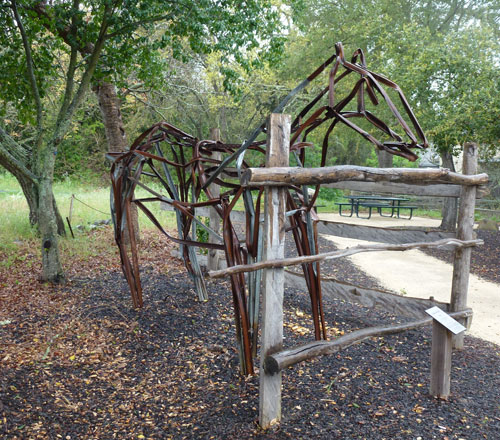
Rex by Jack Chandler

Hopper Creek
Just beyond the gardens was this twisted metal art sculpture or a horse, and across the street from that was the churning Hopper Creek. The rain was coming down fairly hard, and despite our best efforts to stay dry, we were both getting pretty wet. Not to mention by hood kept falling down in front of my eyes and the furry hood-edge was dripping with water, which made my attempts at photography a bit challenging.
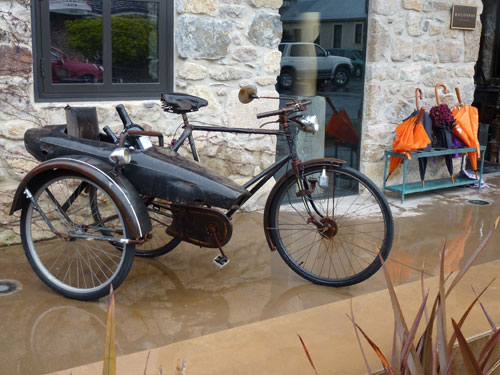
Old Bicycle in Front of Maisonry

Fish Goddess-Small – Bronze Sculpture by Guiseppe Palumbo
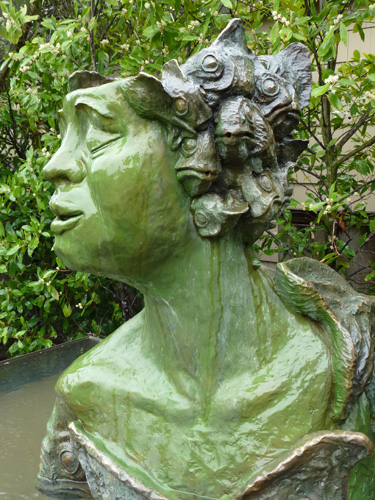
Another View of the Fish Goddess
We came upon a cute stone building, thinking it could be the French Laundry, but instead it turned out to be a winery/art shop called MA(i)SONRY. We were first attracted to the rusty old bicycle in the front, but then a wonderful bronze sculpture in the garden patio behind the building caught my eye. We stowed our umbrella, tried to shake off the water drops, and ventured inside. Michael began to wander while I went out back to get a closer look at the wonderful Fish Goddess. Inside the two-story building it was full of people talking and tasting wine and obviously having a great time. I felt like we had stepped into a private party.
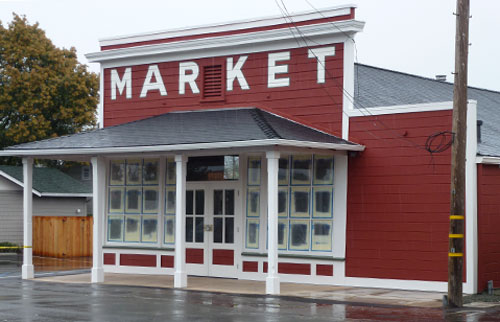
Little Red Market
It was two o’clock, and although we had nibbled on some delectables along our walk, we were still feeling like it was time to dry off, get warm, and eat something a little more substantial. We tried to get a seat at Redd Restaurant (which I had never heard of before but which is apparently another five star eatery) at the North Block Hotel, but the wait was too long, so we decided to head back into the heart of town and try and find a place to eat there.

Town Park Where Weber, Washington, and Humboldt Intersect
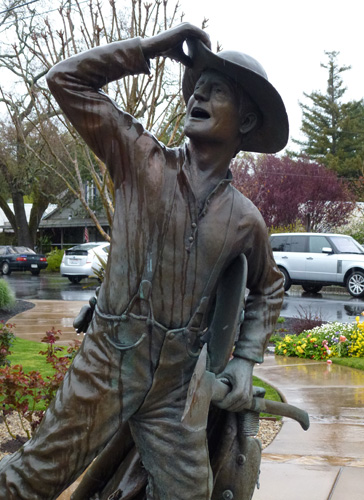
Honorary Firefighters Sculpture by L. C. Shank
The wait was over an hour for the first two places we tried, but then we walked into Hurley’s and were seated right away. What a relief! It felt good to sit down and take off our wet jackets and get warmed up a little. I did just that with a tasty Bloody Mary and a plate of delicious little skewers of meat and hummus. Michael had some buffalo short ribs. This is when we asked the waiter where the French Laundry was, and as soon as he started describing it, we knew it was the old brick building we had seen right across the street from the gardens.

Wisteria Vine Behind Bottega’s
Our second to last stop was chef Michael Chiarello’s fun cooking/food/ accessories store, NapaStyle. During our tasting, I’d gotten a sample of some Truffle Oil Potato chips, and I was there to buy a bag . . . or two. They are made fresh each day and are insanely addicting. Right across is Chiarello’s restaurant, Bottega. We had eaten there a few months before with some friends and had a wonderful meal.

Artist Carl Ciliax
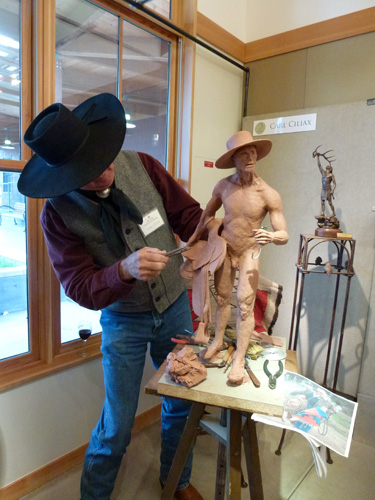
Carl Ciliax at Work
Last stop on the way back to the car was to walk through the Yountville Community Center to look at an exhibit by local artists. Bronze sculptor Carl Ciliax was gracious enough to allow me to take a couple of pictures of him working. His sculptures are amazing!
We were almost done with Taste of Yountville, but Michael and I still had two tickets each left to use. So we both got a delicious cookie and headed back to the car. We didn’t go home, however. Instead we drove up to St. Helena. But that’s a story for another day . . .
